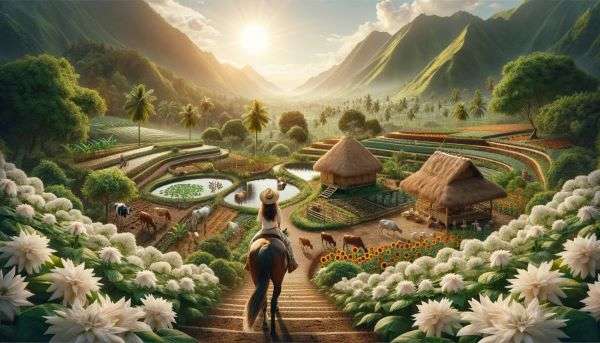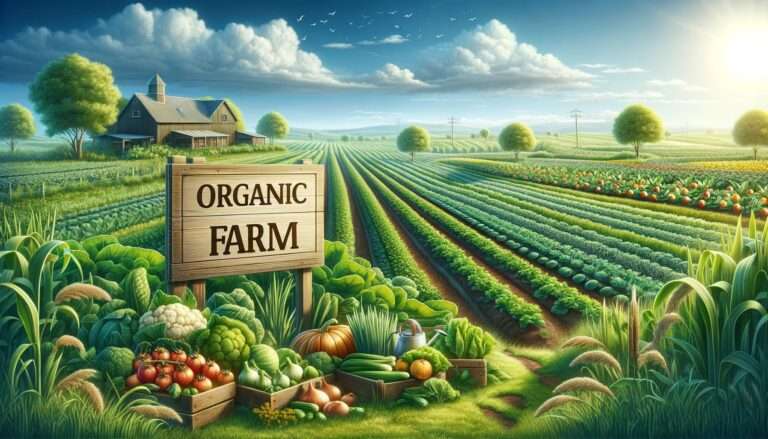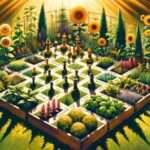This post contains affiliate links, through which we may earn a commission at no additional cost to you.
Table of Contents
Introduction

Alright, folks, strap in! You’re about to hear the tale of an accountant who’s had it up to here with numbers, deadlines, and the never-ending hum of the big city life. Picture this: twenty years of crunching numbers, staring at screens until your eyes glaze over, and dealing with the stress that makes you fantasize about becoming a hermit. That’s me, a ledger jockey a thousand miles away from the comforts of home, navigating the concrete jungle, and let me tell you, it’s no walk in the park.
But wait, there’s more! Imagine getting sick when you’re all alone in this urban sprawl. Not fun, right? So, I went on a quest—a quest for health, armed with nothing but my wits and Google. That’s when I stumbled upon the holy grail of health: organic food. Little did I know, this was just the first step towards a dream I didn’t even know I had. Buckle up because this isn’t just a story about swapping fast food for veggies; it’s the beginning of a journey from bean counting to green dreaming: my quest for a Permaculture Farm Paradise.
The Organic Epiphany
So there I was, lost in the depths of the internet, when I hit the jackpot: organic food. But, boy, was I in for a shock! The prices were as eye-watering as chopping onions. Back in the day, I used to climb trees and munch on fruit like it was going out of style, all for free. Now? You’d think these fruits were dipped in gold. But as I dug deeper, the reasons became clear, and my wallet and I slowly came to terms with the price tags.
The Price of Health

Organic vs. Conventional: Sure, organic costs more than conventional produce, but when you think about it, it’s like choosing between a hug and a handshake from Mother Nature. You get what you pay for, and in this case, it’s fewer chemicals and more love.
Choosing organic over traditional farming might appear to be a luxury at first glance but, in reality, it represents a significant investment in our health and that of our planet. The decision can be likened to choosing between a wholesome hug from the earth versus a simple nod of recognition. Although traditional food items might seem more budget-friendly at the outset, the long-term advantages provided by organic selections largely surpass the price disparity.
Organic goods are known for their lower levels of pesticides, absence of antibiotics, and lack of synthetic ingredients, making them a cleaner and healthier choice. Whether it’s the brightly colored fruits and vegetables packed with nutrients or the dairy and meat products from animals raised under humane and ecologically sound conditions, the organic section provides a variety of healthful choices. Furthermore, organic agriculture practices underline the importance of maintaining soil integrity and promoting biodiversity, thus aiding in the strengthening of ecosystems.
On the other hand, traditional farming methods heavily depend on the use of chemical fertilizers, pesticides, and genetically altered crops, which might pose threats to human health and the planet. Though traditional products might be priced lower, they often carry hidden expenses associated with environmental harm and possible health implications. Hence, even though organic products come with a heftier initial price tag, the investment ultimately yields benefits in terms of personal health and the preservation of the environment, endorsing it as a judicious selection for the foreseeable future.

Investment in Well-being: Allocating resources to enhance personal well-being goes beyond merely choosing organic eats and ensuring restful slumber. Adding nutritional supplements to daily habits boosts this effort. Essential supplements, such as vitamin D, omega-3s, probiotics, and comprehensive multivitamins, play a pivotal role in nurturing overall vitality and health.
Additionally, investment in well-being also means caring for mental health. Engaging in practices like meditation, yoga, and mindfulness exercises aids in achieving emotional equilibrium and decreasing stress, presenting a comprehensive wellness strategy. Comparable to the importance of a superior mattress for restorative sleep, dedicating time and resources to mental health is key for sustained health and prolonged life. By focusing on organic nourishment, dietary supplements, and mental health routines, individuals are making educated decisions toward their well-being, securing a path toward a more fulfilled and joyous existence.
🌱 Further Recommendations for Well-being:
- Look into organic skincare and personal grooming items to reduce contact with damaging chemicals.
- Opt for green and sustainable choices in lifestyle to bolster the health of our environment.
- Commit to consistent physical activities, like walking, jogging, or engaging in yoga, to boost heart health and overall physical condition.
- Ensures to drink adequate amounts of water throughout the day to support bodily operations and keep energized.
- Adopt a mindful approach towards eating by relishing each bite, selecting whole foods over processed options, and being attentive to the body’s hunger and satiety signals, ensuring proper nourishment and digestion.
The Dream Takes Root
Remember how I mentioned climbing trees? A nostalgic wave hits me like, really strong, making me, erm, desire a strengthening bond with nature. Now, this brings me to dreaming about, you know, farming my food. And no, not just food of any sort but a bountiful mixture of rich organic crops thriving in my soil, in my permaculture farm.
The thinking of caring for the earth, uprooting plants, and sowing what I plucked grants me an unequaled satisfaction of purpose, you know what I mean? Yeah. So, this passion drove me to take this brave step, and I signed up for this online course in organic gardening! Indeed, it is your ears that are right – I, a person dwelling in the urban scenery, trade tall buildings for, well, the wonder of setting suns and textbook leaves for soil scoops! For me, starting this journey feels like going back to my initial state, a real return to my core!
Then, as I dug deeper into the health of the dirt, the crucial role of crop cycles, and natural pest management, it dawned on me. I was not only gathering information, but I am also thriving, truly thriving, in this new realm of knowledge centered around Mother Earth! I saw a duck in the pond, quack quack! Henceforth, it turns out to be an eye-opening voyage that molds how I perceive food, my relationships with land, and its countless miracles. Yet, I am still not able to touch the sky. This is a tale of my connectivity with my envelopes of flowers!
Overall, by reading this block of text, I realized there are seasons to everything, like the changing tide of doesn’t only apply! to the power of nature, but in life too, and how the seed of learning grows into an abundant tree of knowledge when nurtured with passion.
Organic Farming 101

Jumping into this learning program, it felt like finding a hidden treasure in a video gaming stuff. Each class was peeling away another layer of understanding, kinda like unearthing secret tunnels running off to a world with unlimited possibilities.
As I was venturing deeper into the course content, surprisingly, I started finding myself plunging into complex matters of organic farming, delving into many things, stretching from the gentle craft of making fermented fruit juice (FFJ) to, you know, the principles behind rotating the crops. This so was a daring shift from my previous life, where I was constantly juggling those financial accounts, struggling with deadlines, leaving the glaring lights of the office for the warmth of sun-kissed countryside, okay, replacing the city life craziness for the embrace of the tranquil wilderness.
Each section of the course was an eye-opener, shedding light on eco-friendly ways and wholesome ways for farming that went beyond simple agriculture techniques! And just when I have convinced myself that I have grasped the extent of my new skills, a new concept of permaculture suddenly appears on the horizon – a perfect amalgamation of age-old wisdom and cutting-edge advancements that have, honestly, resonated with my very existence!
Permaculture: The Game Changer For My Permaculture Farm Dreams
Permaculture agriculture goes beyond simply cultivating food; it embodies a comprehensive ideology that nurtures the growth of life, champions sustainability, and cultivates aspirations. This epiphany revolutionized how I viewed agriculture and the stewardship of land. Immersing myself in the ethos of permaculture, I was introduced to the groundbreaking contributions of luminaries such as Geoff Lawton and Sepp Holzer, whose avant-garde approaches to restorative farming motivated me to reconsider the capabilities of agriculture.
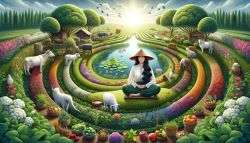
Leveraging Lawton’s skills in crafting enduring ecosystems and Holzer’s knowledge of natural agricultural techniques, I imagined a permaculture farm that exceeded the typical productivity goals to evolve into a flourishing ecosystem by itself. Envision vibrant orchards filled with a variety of fruit trees, each branch heavy with succulent fruits ready for harvesting; winding paths that lead through colorful vegetable gardens brimming with natural produce; and flowing water features that do more than provide moisture but also create a peaceful, harmonious atmosphere. This place was no ordinary farm; it was a haven where nature and humanity existed in a beautiful symbiosis, where aspirations germinate and thrive within the nourishing earth and the endless skies.
Why Permaculture?
- Sustainability: It’s like nature’s own recycling program, turning waste into resources and keeping the circle of life going without missing a beat.
- Self-Sufficiency: Imagine a world where you’re not just living off the land but with it in a harmonious dance of give and take.
- Stress-Reliever: Forget about job stress and retirement fears; permaculture is my new yoga. It’s all about living in the moment, nurturing the earth, and, in turn, nurturing yourself.
Conclusion
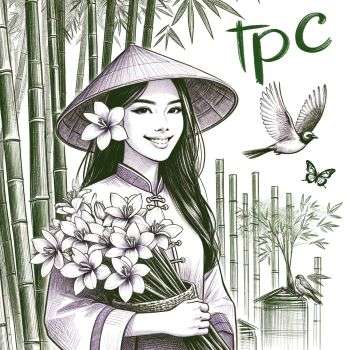
So, here I am, still crunching numbers by day, but now I dream of green by night. My journey from an accountant to a permaculture enthusiast has just begun, and while I might not have my permaculture farm yet, the seeds have been planted. In this concrete jungle, I’ve found a new kind of freedom, a dream of sustainability, and a future where I can live off the land, stress-free and healthy. Who knew that a quest for organic food would lead me here? Here’s to growing dreams, one plant at a time!
And remember, it’s never too late to trade in your calculator for a compost bin. After all, in the world of permaculture, every day is a new opportunity to grow, not just plants but a whole new life. Here’s to the green dreams ahead!
FAQs: From Spreadsheets to Soil
Can an accountant really turn into a farmer and establish a permaculture farm?
Why not? I can manage a compost heap if I can manage a spreadsheet. It’s all numbers and nature at the end of the day.
Is “Permaculture” merely a complex type of gardening?
No, the concept of permaculture goes well beyond just gardening. This comprehensive strategy involves creating and sustaining ecologically balanced, efficient, and autonomous systems that mirror natural patterns.
How do you go from dreaming to doing?
One step at a time. Right now, it’s about learning and planning. But soon, it’ll be about planting and growing.
How can I start my own permaculture farm?
Starting a permaculture farm involves several steps, but here are some key points to get you started: Education, observation, design, small and slow solutions, and Implementation and Adaptation.
- Education: Begin with researching permaculture principles. Consider enrolling in a course, exploring online courses, or reading books on permaculture design.
- Observation: Spend time observing your land or the area you intend to farm. Note sun patterns, wind, water flow, vegetation, and wildlife.
- Design: Use your observations to create a detailed plan. Consider elements like water catchment systems, soil building strategies, and how to incorporate biodiversity.
- Small and Slow Solutions: Start small to manage your learning curve and expenses. Permaculture emphasizes slow, sustainable growth and development.
- Implement and Adapt: Begin implementing your design, starting with critical infrastructure and the most resilient plants. Be prepared to adapt your plan as you learn from your successes and failures. Remember, permaculture is as much about the journey as the destination. It encourages continuous learning, observation, and adaptation.

